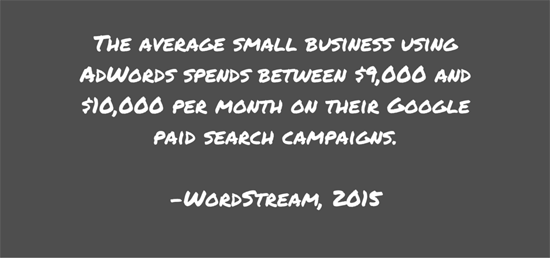There are two ways to get seen on Google. You can either pay for ads that will display on top of search results, or invest in search engine optimization (SEO) to appear organically below the ads.
If you choose to go the advertising route, it’ll cost you at least $1 to $2 per click, but it can be more than $50 per click, according to WordStream. In fact, the average small business that signs up for AdWords spends between about $100,000 to $120,000 per year to be seen via paid search.

SEO, on the other hand, can be much more sustainable for small businesses. If you have the means but you don’t have the time, you may want to pay for a firm to take over your SEO campaigns.
WHY HIRE AN SEO FIRM?
When you invest in AdWords, it’s a short-term solution. However, if you hire a good SEO firm with a portfolio of positive results, they’re going to be focused on more long-term goals and work with your business to organically build traffic.
SEO is a full-time job, which is why many small businesses choose to hire firms instead of doing it themselves. Firms dedicate all of their energy and resources to the task of improving your SEO.
A decent SEO firm will charge between $5,000 to $10,000 per month, according to Brian Honigman (also read, “The Average Costs for SEO Services”). At this price point, you’re working with a company that has a staff of experienced content managers, Web developers, copy editors and analytics experts. The average cost of paying for specific services like website and SEO audits is $1,000 to $3,000. Link building costs $250 to $2,000 per link, and copywriting is 75 cents to $1 per word.
If you do hire an SEO firm, make sure that they’re up to date with Google’s requirements. Though no one can pinpoint exactly what algorithm Google uses to rank sites, it is known that they are looking at mobile optimization and the authority and relevance of your content.
Your SEO firm should be concentrating on building up your site overtime. SEO is not a quick fix, and it can take months upon months to see results. When you add too many keywords to try and rank higher in a short amount of time, you may end up getting penalized by Google.
Your firm should also have a solid client list and a great track record, and talk about the importance of website content. If a firm is all about littering your website with relevant keywords and not even discussing content marketing, find another company.
Just because you hire an SEO firm, it doesn’t mean that you should step away from SEO efforts completely. Your whole team has to be involved in the process by thinking of content to create for your business and analyzing your analytics. You must always monitor your firm, and make sure you’re getting what you pay for.
WHY DO SEO ON YOUR OWN?
At this point in time, you may not have the available funds to invest in an SEO firm. Or, you’ve had negative experiences with SEO firms in the past and you want to try it on your own for a while.
If you dedicate time to improving your SEO, you may see better results than a firm would provide. After all, no one cares about your business more than you do.
Another option, aside from doing it on your own, is to hire an SEO team member, which is a big investment up front that can lead to a huge pay off. This person will be much more invested in your company than a firm and know your business inside and out. You can see your analytics whenever you want, and personally consult with your specialist anytime. If you’re not ready to take on a full-time team member, you can hire a consultant for $100 to $300 per hour.
There are many resources available online for improving your SEO. After all, this is the age of DIY. If you’re choosing to go on this path, here are a few pointers to give you a head start.
QUICK TIPS FOR GETTING STARTED WITH SEO
1. Create content that will attract your demographic to your website. Start a company blog that incorporates engaging images and video along with text and internal links to your website. Promote your blog and content on all your networks including your social media sites, since that’s where people are clicking through to content nowadays. Make sure content on your blog is unique and can’t be found elsewhere.
2. Incorporate keywords into your posts, but don’t go crazy. Make sure they fit in organically within your piece. To find out which keywords are best for you, use an SEO keyword research tool.
3. Utilize all the SEO tools within your website builder for your blog posts. Include tags, make sure your search engine description is filled out, come up with an enticing headline, and use a descriptive URL.
4. Focus on getting linked on high-quality websites. According to Felix Tarcomnicu, an effective method is to monitor your competitors’ backlinks and aim at getting links placed on those same sites. You don’t want links on any website, especially ones that see little traffic.
5. Make sure your page is loading fast enough with Google’s PageSpeed Insights. Otherwise, Google may penalize your ranking if your site loads too slow.
A solid SEO plan is crucial for your business to succeed. Whether you hire an SEO firm or take it on yourself, make sure that it’s a priority for your company.
